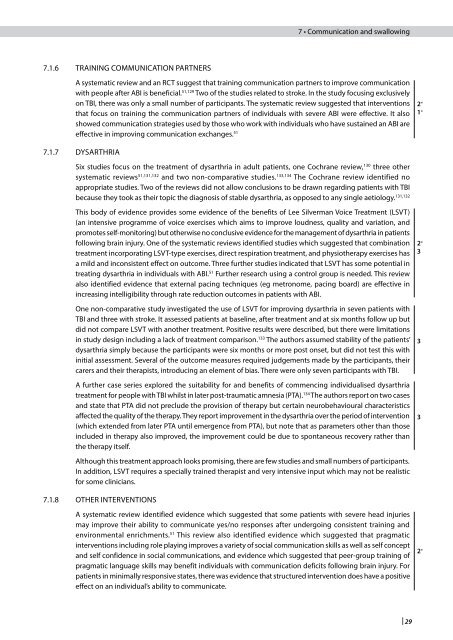sign130
sign130
sign130
Create successful ePaper yourself
Turn your PDF publications into a flip-book with our unique Google optimized e-Paper software.
7.1.6 TRAINING COMMUNICATION PARTNERS<br />
A systematic review and an RCT suggest that training communication partners to improve communication<br />
with people after ABI is beneficial. 51,129 Two of the studies related to stroke. In the study focusing exclusively<br />
on TBI, there was only a small number of participants. The systematic review suggested that interventions<br />
that focus on training the communication partners of individuals with severe ABI were effective. It also<br />
showed communication strategies used by those who work with individuals who have sustained an ABI are<br />
effective in improving communication exchanges. 51<br />
7.1.7 DySARTHRIA<br />
Six studies focus on the treatment of dysarthria in adult patients, one Cochrane review, 130 three other<br />
systematic reviews 51,131,132 and two non-comparative studies. 133,134 The Cochrane review identified no<br />
appropriate studies. Two of the reviews did not allow conclusions to be drawn regarding patients with TBI<br />
because they took as their topic the diagnosis of stable dysarthria, as opposed to any single aetiology. 131,132<br />
This body of evidence provides some evidence of the benefits of Lee Silverman Voice Treatment (LSVT)<br />
(an intensive programme of voice exercises which aims to improve loudness, quality and variation, and<br />
promotes self-monitoring) but otherwise no conclusive evidence for the management of dysarthria in patients<br />
following brain injury. One of the systematic reviews identified studies which suggested that combination<br />
treatment incorporating LSVT-type exercises, direct respiration treatment, and physiotherapy exercises has<br />
a mild and inconsistent effect on outcome. Three further studies indicated that LSVT has some potential in<br />
treating dysarthria in individuals with ABI. 51 Further research using a control group is needed. This review<br />
also identified evidence that external pacing techniques (eg metronome, pacing board) are effective in<br />
increasing intelligibility through rate reduction outcomes in patients with ABI.<br />
One non-comparative study investigated the use of LSVT for improving dysarthria in seven patients with<br />
TBI and three with stroke. It assessed patients at baseline, after treatment and at six months follow up but<br />
did not compare LSVT with another treatment. Positive results were described, but there were limitations<br />
in study design including a lack of treatment comparison. 133 The authors assumed stability of the patients’<br />
dysarthria simply because the participants were six months or more post onset, but did not test this with<br />
initial assessment. Several of the outcome measures required judgements made by the participants, their<br />
carers and their therapists, introducing an element of bias. There were only seven participants with TBI.<br />
A further case series explored the suitability for and benefits of commencing individualised dysarthria<br />
treatment for people with TBI whilst in later post-traumatic amnesia (PTA). 134 The authors report on two cases<br />
and state that PTA did not preclude the provision of therapy but certain neurobehavioural characteristics<br />
affected the quality of the therapy. They report improvement in the dysarthria over the period of intervention<br />
(which extended from later PTA until emergence from PTA), but note that as parameters other than those<br />
included in therapy also improved, the improvement could be due to spontaneous recovery rather than<br />
the therapy itself.<br />
Although this treatment approach looks promising, there are few studies and small numbers of participants.<br />
In addition, LSVT requires a specially trained therapist and very intensive input which may not be realistic<br />
for some clinicians.<br />
7.1.8 OTHER INTERVENTIONS<br />
7 • Communication and swallowing<br />
A systematic review identified evidence which suggested that some patients with severe head injuries<br />
may improve their ability to communicate yes/no responses after undergoing consistent training and<br />
environmental enrichments. 51 This review also identified evidence which suggested that pragmatic<br />
interventions including role playing improves a variety of social communication skills as well as self concept<br />
and self confidence in social communications, and evidence which suggested that peer-group training of<br />
pragmatic language skills may benefit individuals with communication deficits following brain injury. For<br />
patients in minimally responsive states, there was evidence that structured intervention does have a positive<br />
effect on an individual’s ability to communicate.<br />
| 29<br />
2 +<br />
1 +<br />
2 +<br />
3<br />
3<br />
3<br />
2 +


